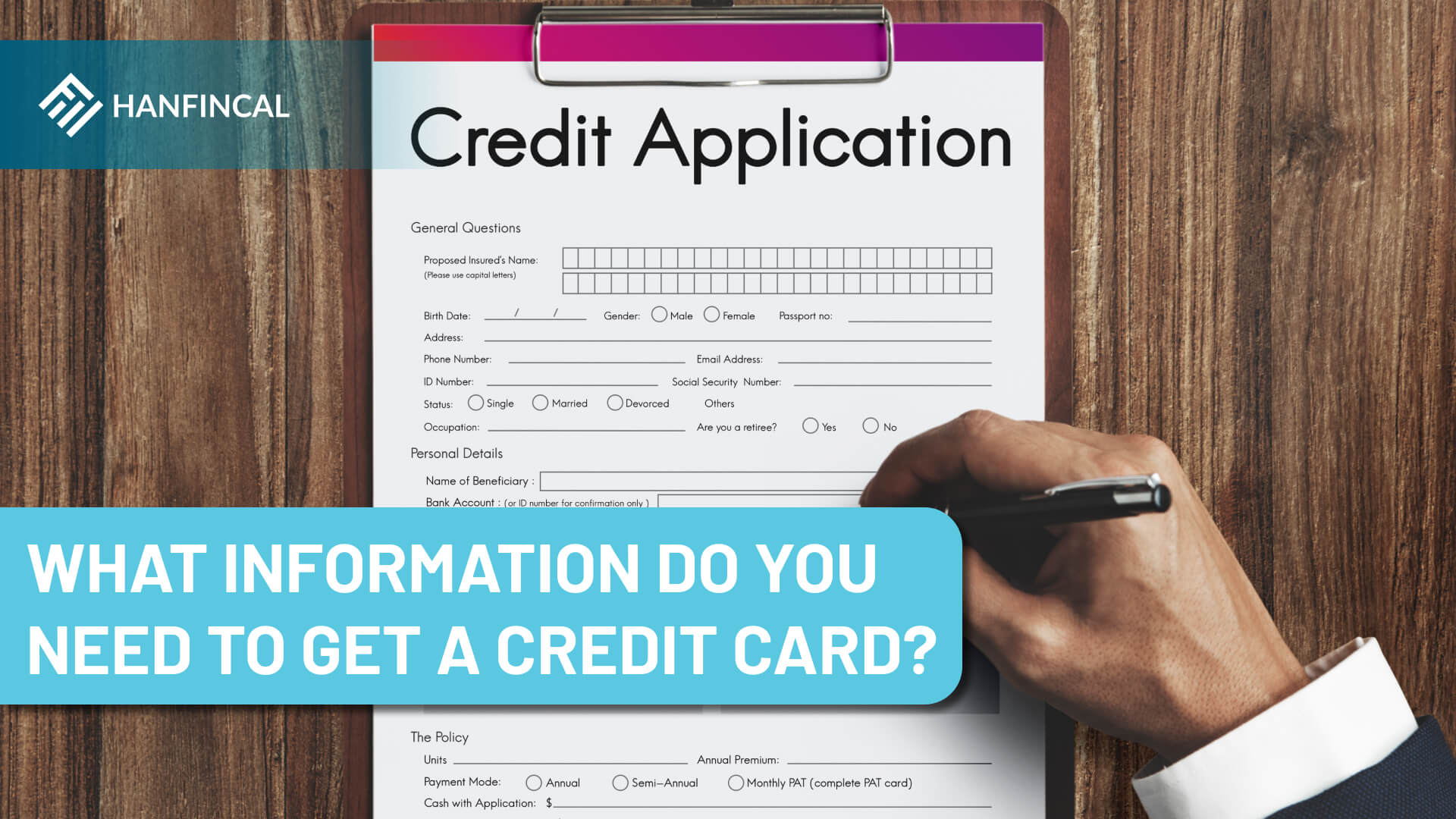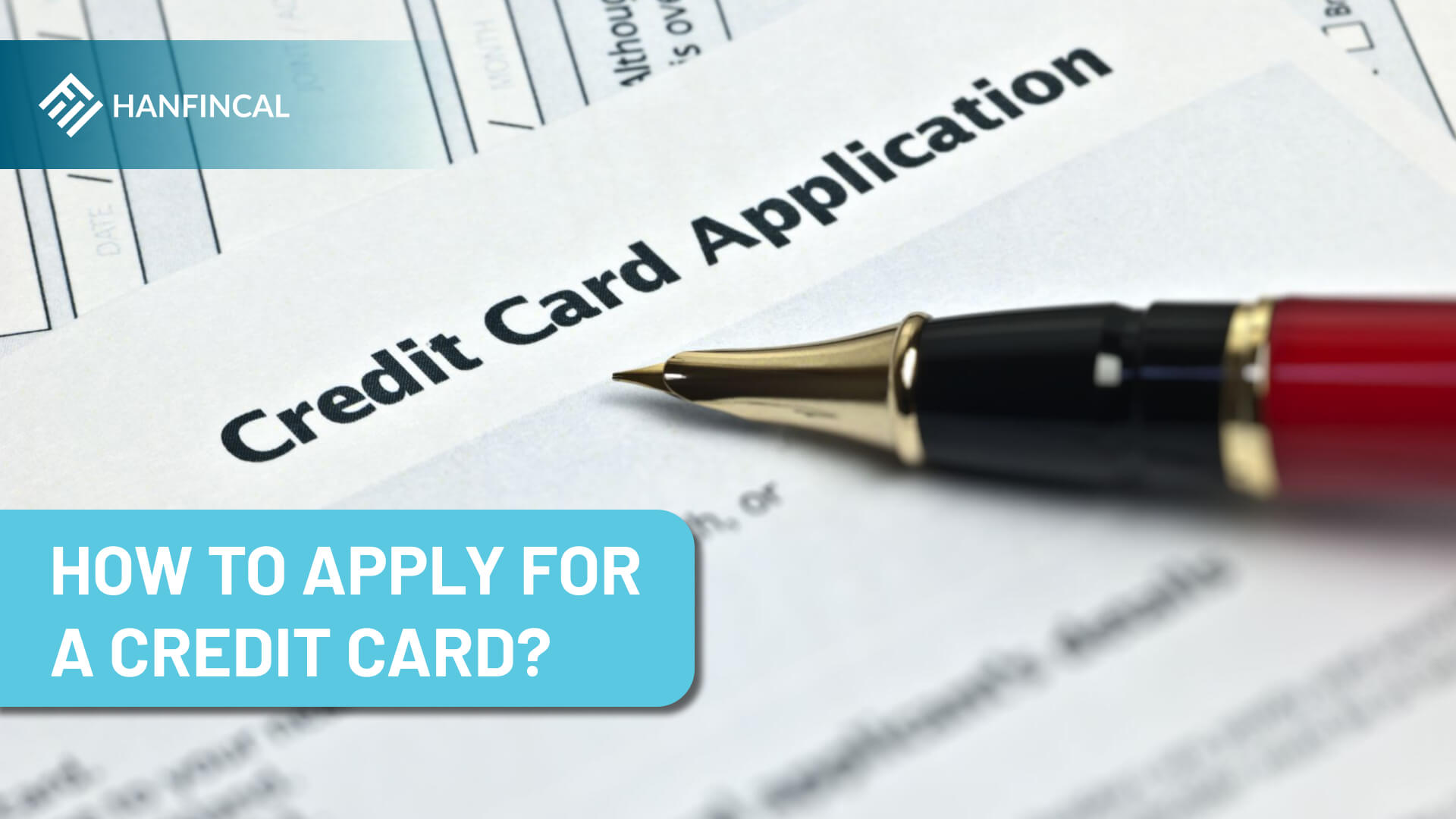Having a credit card is not an unusual task for everyone. However, it is relatively difficult for those applying for the first card. So, how to apply for a credit card and get it quickly? Check out the article below for a helpful guide from Hanfincal.
1. What information do you need to get a credit card?

What information do you need to get a credit card?
1.1. Personal information
When applying for a credit card, you have to provide personal information to the credit card issuer. Please make sure that the following information is complete and accurate:
- Personal data: full name or date of birth.
- Citizenship: the US or other countries.
- Residential address: your current home address and how long you’ve lived there.
- Individual Taxpayer Identification Number (ITIN) or Social Security Number (SSN).
- Contact information: a valid email address and a phone number.
1.2. Income information
Your income information will assist the credit card issuer to determine how much to approve for your credit limit. As a result, if you have any source of income, please list it accurately and honestly; if your income level meets the requirements, you will most likely be granted a high credit limit. Here is the information you must provide to demonstrate that you have a stable source of income:
- Your occupation: Provide your title, field, and whether you work full-time or part-time.
- Employer information: Give the name and contact information of your current employer.
- Income sources: Include information about your annual income before taxes and any additional income you may receive, such as benefits or child support.
- Self-employed situation: You may be required to provide your previous year’s income tax returns to verify your income.
1.3. Financial information
Aside from your income, your financial information is important in determining the amount of your credit limit. This is the most compelling evidence to support your claim that you can afford to repay credit card loans. The following information will be required from you:
- Assets: Savings, investments, and property are examples of assets.
- Account details: Savings and checking account information, as well as current balances
- Monthly housing payments: Enter the amount of your mortgage or rent payment each month.
- Credit and other bets: Provide your current credit accounts or debts, such as credit cards, personal loans, or car payments.
2. How to apply for a credit card?
You can apply for a Credit Card by following 8 easy steps:
- Check credit card eligibility criteria
- Know your credit score and its meaning
- Choose the right type of credit card
- Learn the terms of a credit card application
- Check for pre-approval
- Choose where to apply for a credit card
- Fill out a credit card application and submit
- Get credit card in your mail

How to apply for a credit card?
2.1. Check credit card eligibility criteria
- Credit score: If you have a low credit score, it may affect your eligibility.
- Age: To apply for a credit card, you must be 21 years old, according to the official credit card eligibility criteria. If you are 18, you may still be eligible for a credit card if you have permission from your parents or a verifiable source of income.
- Income: This is one of the most important criteria for approving a credit card application. Most credit issuers will require you to be employed and earn a certain amount of money each year.
- Status of residency: permanent resident or citizen of the United States
- Credit history: To apply for most credit cards, you must have a good credit history. However, you can start rebuilding your credit with a secured credit card if you have no credit.
2.2. Know your credit score and its meaning
2.2.1. Breakdown of credit score ranges
A credit score plays the most important role in a credit card issuer’s decision to approve your application. FICO and VantageScore are the two primary credit scoring systems. Here are the credit score ranges for each system.
| Range | FICO | Range | VantageScore |
| Excellent | 800 – 850 | Excellent | 781 – 850 |
| Very good | 740 – 799 | Good | 661 – 780 |
| Good | 670 – 739 | Fair | 601 – 660 |
| Fair | 580 – 669 | Poor | 500 – 600 |
| Poor | 300 – 579 | Very poor | 300 – 499 |
2.2.2. Check your credit score and report
VantageScores and FICO scores track similarly because they weigh many of the same factors and use the same credit bureau data. AnnualCreditReport.com allows you to request one free annual credit score and credit report from one of the three major credit bureaus: Experian, TransUnion, and Equifax.
Furthermore, some credit card companies provide free access to your FICO or VantageScore through your account. Examine this offer by visiting its website, contacting customer service, or simply exploring your account.
2.3. Choose the right type of credit card
The following are some common types of credit cards that you should not overlook when shopping for one:
- Balance transfer credit cards let you transfer your existing credit card balance to another card with a lower or no interest rate. Furthermore, this type of credit card can assist you in consolidating your existing debt.
- Cashback credit cards: They pay you a percentage of what you spend (for eligible spending) each time you use your credit card to make a purchase.
- Rewards cards help you earn rewards in cash back, points, or miles based on a percentage of your spending.
- 0% APR cards: These cards have an introductory 0% APR offer on purchases, balance transfers, or both.
- Credit builder credit cards: Credit builder cards, designed for people with little to no credit history, can help you boost your credit score over time.
- Travel credit cards are designed to be used abroad because they do not charge high foreign transaction fees.
- Purchase credit cards that allow you to spend and then pay off the balance over time, often with a zero percent interest period for a few months.
2.4. Learn the terms of a credit card application
Here are some typical credit card terms and their definitions:
- APR for balance transfers: The interest rate reflects the total annual interest cost on the credit card balance transferred from one outstanding credit card to another.
- Balance transfer fee: This fee typically ranges between 3% and 5% of the total amount transferred.
- Annual fee: This fee allows you to use the card and receive associated benefits, such as cash back rewards.
- Cash advance APR: The interest rate reflects the total annual interest cost on the cash borrowed against your credit card balance.
- Cash advance fee: Many credit card companies charge a cash advance fee per transaction, typically ranging from 3% to 5%.
- Purchase annual percentage rate: If you do not pay the balance in full each month, the interest rate reflects the total yearly cost of the interest on your card purchase balance.
- A transaction fee is charged in addition to the APRs for each type of transaction made by a borrower.
- Minimum interest charge: This amount is charged if you carry a balance on your card from one billing period.
2.5. Check for pre-approval
Pre-approval or pre-qualification is a step toward increasing your chances of receiving official approval for your credit card. Typically, you must fill out a brief form and provide personal information, including your Social Security number. Pre-approval only involves a soft inquiry, not affecting your credit scores. And if you do get pre-qualified, your chances of getting an account are higher.
2.6. Choose where to apply for a credit card
- Website: Applying for a credit card through the bank’s website is the quickest way. If you apply online, you should receive a response quickly.
- On the telephone: When you apply over the phone, you will receive a fairly quick response regarding your application. However, you may encounter long wait times with phone applications and be placed on hold.
- In-person: You can also apply for a credit card in person. You’ll get a quick response when your application is approved, and you’ll be able to ask questions about the card or application in real-time.
- Mail: Applying by mail is the least efficient of all options. You have to wait for your application to be received by the issuer and mail back a response, which could take several weeks.
2.7. Fill out a credit card application and submit
Another option for assisting you in applying for a credit card is finding and filling out a credit card application. Your name, address, income, bank account balance, Social Security Number (SSN), and monthly housing payment are typically required in this option. Some credit cards are available without an SSN, while others may require additional information.
2.8. Get credit card in your mail
You will receive your credit card once your application has been approved. After approval, you should receive it in the mail within 7-10 business days. However, many credit card companies offer expedited delivery if you request it, and it is frequently free.
3. What to do if your application is denied?
A credit card issuer may deny your application for a variety of reasons. If you have a low credit score due to a history of late payments or don’t have any credit because you’re just getting started with it, this could also work against you. What should you do now? Here are some things you can do:
- Determine the reason for the rejection: The credit card company should send you a letter outlining the denial.
- Determine whether to request reconsideration: If your denial was caused by an error in the information you provided, you might request reconsideration.
- Create a strategy for future applications: You could improve your credit score or increase your income, then reapply for your desired card.
- Consider becoming a registered user: You can always become an authorized user on another person’s account, which does not necessitate a credit check.
The specific steps above on how to apply for a credit card will make it easier for you to determine what to do and how to do it, especially if you are applying for your first credit card. If you are rejected, look for another chance to be approved.
==> Read More:




